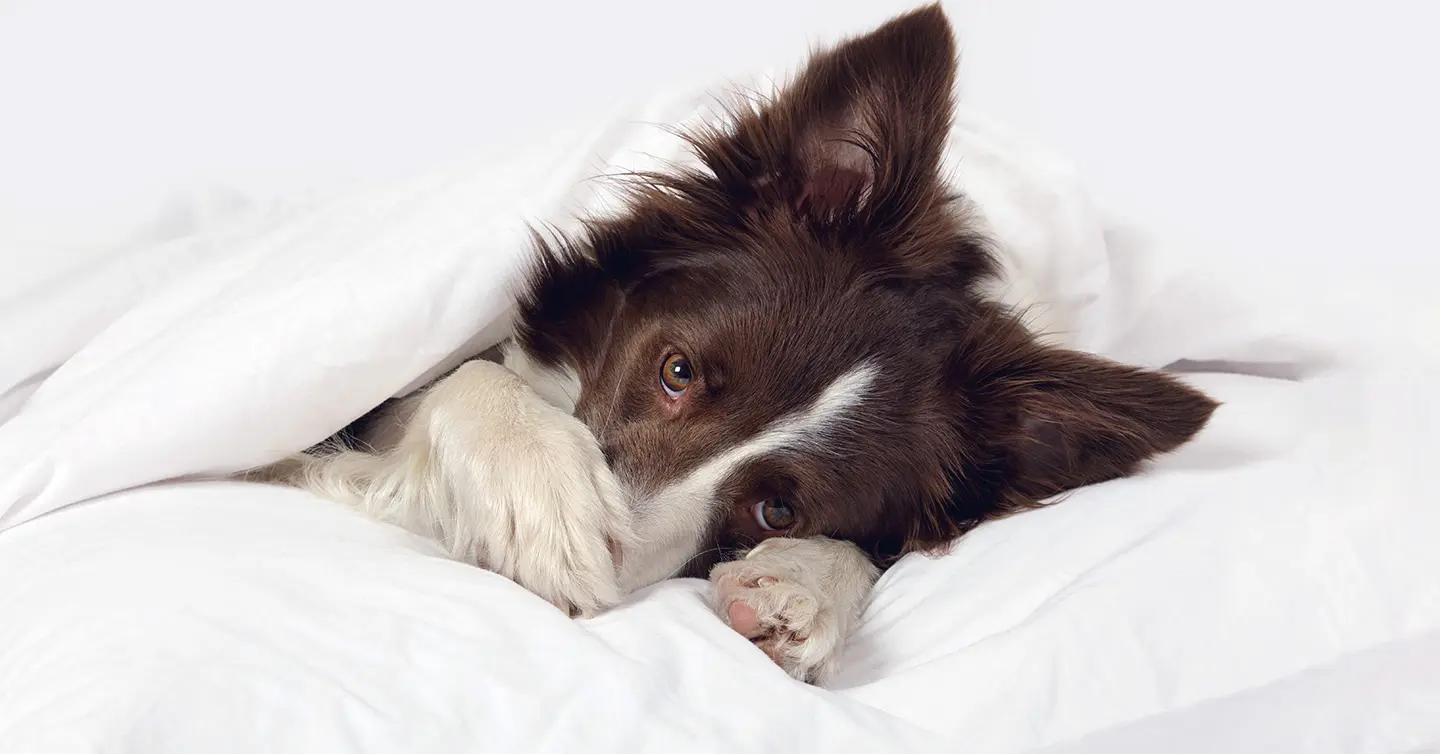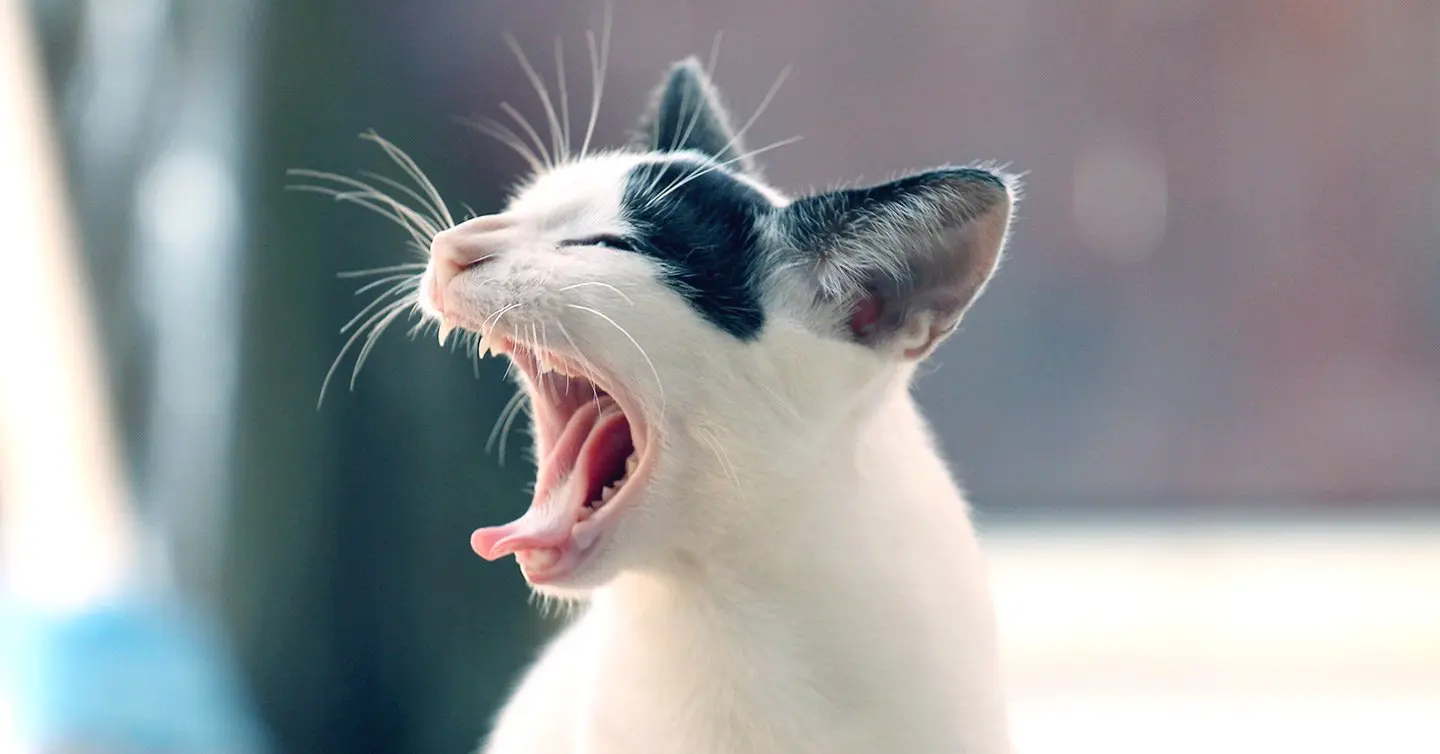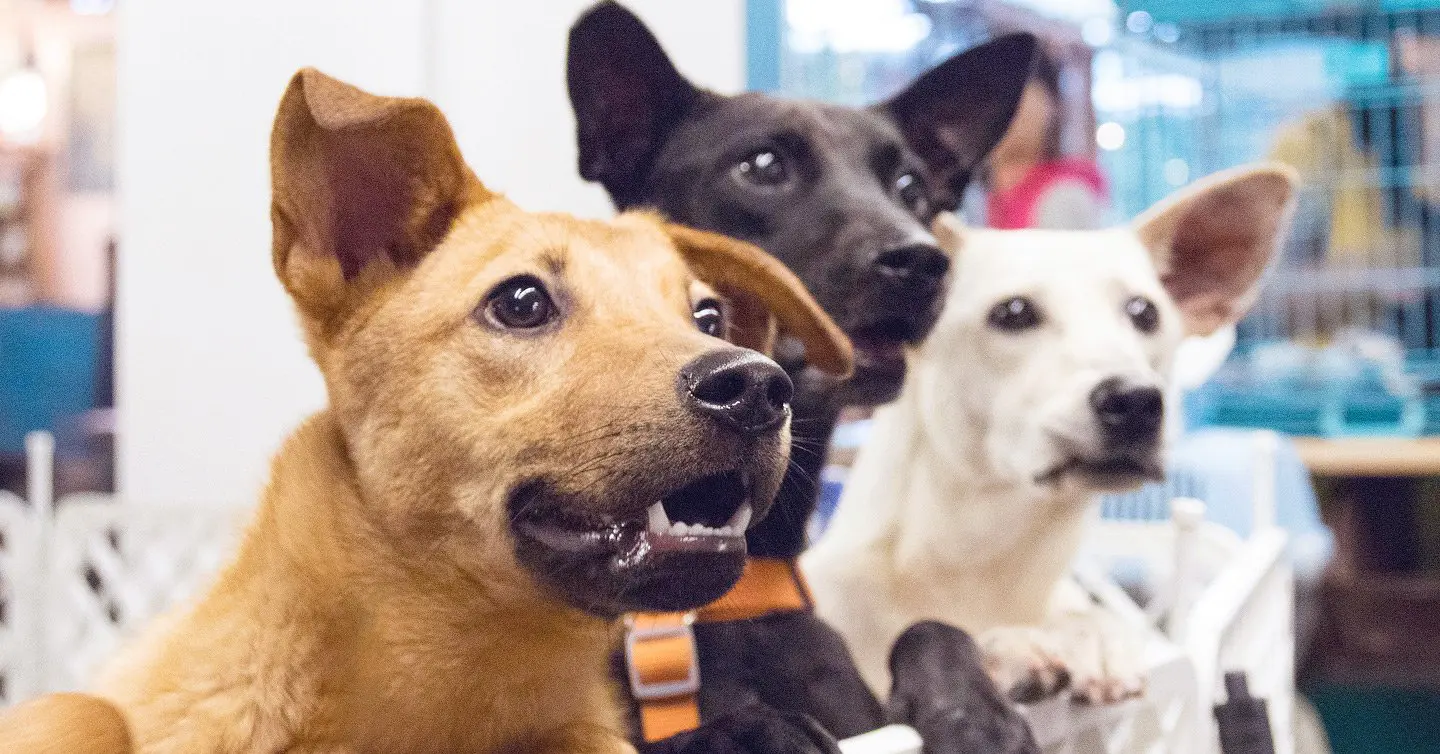Key Points
- Big dogs may look tough, but many giant breeds are gentle and loyal companions.
- The biggest dog breeds weigh over 170 pounds, and people affectionately call them bears or horses.
- Large dogs often have shorter lifespans than smaller breeds.
When you spot a large dog on the sidewalk, it’s normal to feel intimidated. Some breeds might weigh more than you do and have the ability to knock you over with one playful jump.
The truth is, though, that most big dog breeds are huge sweethearts. They are overflowing with love and affection for their families (and sometimes even for strangers). Some giant breeds are also overflowing with drool, but we’ll get to that.
Each giant breed has its own set of quirks. Some are vigilant guard dogs with loud barks, while others are timid softies who prefer to nap. There are those who need high-intensity exercise, and others who don’t mind spending the day curled up on the couch. Some have long histories as herding or shepherd dogs, while others are known as fierce and resolute hunters.
But there’s one thing the world’s biggest dogs all have in common, and that’s their giant stature. Giant dog breeds can measure up to 28 inches and weigh between 90 and 180 pounds — or more!
Are you thinking about adopting a big pup? Check out this list of 15 extra-large, extra-lovable dog breeds to discover which one is right for you.
1. Great Dane

Clocking in at a whopping 110 to 175 pounds and 28 to 32 inches tall, the Great Dane is one of the biggest (and friendliest) dogs out there. In fact, these pups have earned the nickname “Gentle Giants” for being sweet, dependable, and patient, and they’re great dogs to have around young children.
They’re affectionate with their families and make good watchdogs — they’re as protective and alert as they are large. And when they stand on their hind legs, they’re taller than most humans.
Great Danes require a brisk walk two to three times a day and also love a good jog, hike, or game. However, their expert noses mean they should be kept on a leash at (almost) all times, as their sniffs can lead them just about anywhere.
To be safe, you should only let your Great Dane off their leash in areas with tall fences. Great Danes’ life expectancy is only about 7 to 10 years.
2. Saint Bernard

Saint Bernards are among the most charming of pups and popular family dogs. They’re so playful and protective that they make some of the best friends out there.
In the past, Saint Bernards’ 120 to 180-pound weight and 26 to 30-inch height made them excellent rescuers of lost travelers from the freezing cold Alps. They were also used as herders and guard dogs. Today, they’re quiet, easygoing indoor dogs that love snuggles and children.
While they can tolerate pretty chilly weather, they don’t like to be left outside too long — they’ll choose the carpet over the grass any day.
However, Saint Bernards require a mild amount of exercise, and one walk each day should be enough to keep them happy and healthy. They don’t do well in warm weather, so make sure that any summer outing is free of high-intensity exercise and they have plenty of water.
While Saint Bernards are among the best dogs for anyone looking for an intelligent and playful pup, they’re not for neat freaks. Saint Bernards are known to shed and drool quite a bit, which means a home with a Saint Bernard may never be spotless.
3. Newfoundland

A 100 to 150-pound and 26- to 28-inch Newfoundland can look powerful and intimidating. However, these shaggy pooches — nicknamed Newfies — are sweethearts through and through.
The Newfie breed standard says that a sweet temperament is the “most important single characteristic of the breed.”
Newfies are adorably affectionate and kid-friendly, and they’ll often greet other dogs and strangers with friendly licks and nuzzles. They’re smart and easy to train, picking up new skills quickly (especially when you train them young).
They’re pretty adaptable to routine and environment, though they won’t be thrilled about living in a small apartment. And they’re known to make great therapy dogs.
Newfies are also strong swimmers and historically worked as rescue swimmers in the Canadian province of Newfoundland, so they’ll be more than happy to be your lovable pool day companion. In fact, their joints can be delicate, which makes swimming the ideal low-impact form of exercise for your sweet, sweet Newfie.
4. Leonberger

Leonberger dogs, or Leos for short, can be anywhere from 90 to 170 pounds and 25.5 to 31.5 inches tall. To say they’re huge is an understatement, and while they could probably knock you right over, they’re gentle and friendly pups.
With the right training, they can be good family pets, as they’re affectionate with their family and great with children. Most Leonbergers are happy to live in an environment with other dogs, too.
They’re hard-working and intelligent, making them no-nonsense watchdogs despite their friendly disposition. Your Leo will change a lot from puppyhood to adulthood. As puppies, they’re vivacious and energetic, while subdued and relaxed as adults.
However, even adult Leos need a bit of exercise every day, and they enjoy activities like jogging and hiking. A Leo’s life expectancy is only 7 years, but this short time with your dog will definitely be sweet.
5. Irish Wolfhound

Then there’s the Irish Wolfhound, the tallest dog of all those recognized by the American Kennel Club (AKC). Standing at a 30-inch minimum (yes, minimum) and weighing 105 to 120 pounds, these dogs tower over just about anything.
They’re calm and dignified with lots of affection to give, and they get along well with other pups.
And, unlike lots of other giant dog breeds, the Irish Wolfhound isn’t meant for standing guard. That means they don’t bark as much as other big dogs, and while they can be described as courageous, they’re not aggressive. In most cases, they enjoy getting to know strangers.
Though they might be tall, Irish Wolfhounds are short-lived pups with a lifespan of only 6 to 8 years. However, give your Wolfhound lots of space to romp and remember to brush their hair, and they’ll love you all the while.
6. Greyhound
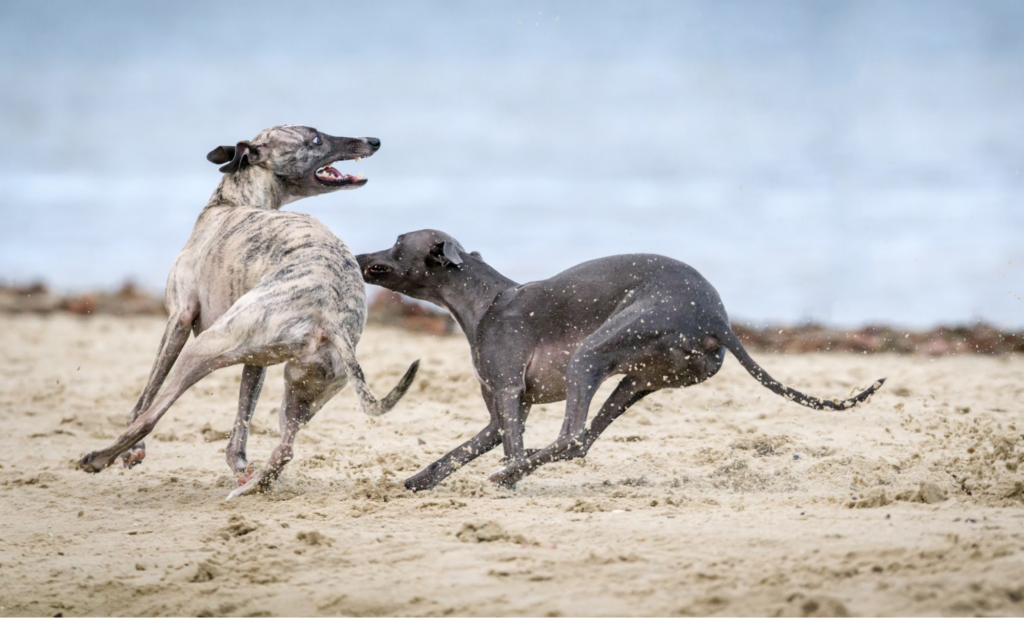
Greyhounds are a super-fast breed, reaching speeds of up to 35 miles per hour. Their running prowess and abilities as a sighthound means greyhounds have a history as race dogs and hunters.
As adults, these lean and muscular canines measure 27-80 inches and weigh up to 70 pounds.
If you adopt a greyhound, you’ll get an affectionate and gentle friend. They’re independent and easy-going and can be good with other dogs.
Greyhounds can live with children if they’re socialized from a young age. And, with short hair, minimal shedding, and low drooling levels, these beautiful giants are low-maintenance.
While they don’t mind chilling, you should also schedule some run time for your racer. Just be aware that when a greyhound catches a scent, their hunting instincts can kick in — so a secure yard is a must.
The average life expectancy of a greyhound is 10 to 13 years, which is rare among the biggest dog breeds.
7. Bernese Mountain Dog

The Bernese Mountain Dog is a 70 to 115-pound, 23 to 27.5-inch buddy. The Bernese Mountain Dog, from the Swiss Alps, is a triple threat: affectionate, kid-loving, and good with other dogs.
They’re hard-working dogs who will do just about anything to please their owners (or earn a treat), and they’re easy to train. They’re also good watchdogs with loud barks. While protective, they can easily warm up to strangers with enough socialization.
The Bernese Mountain Dog has lots of energy, so owners should be up for some exercise. Bernese Mountain Dogs need at least a half-hour of moderate exercise every day, and they thrive doing outdoor activities like hiking and camping.
Like many larger dogs, these pups only have a 7 to 10-year life expectancy and are prone to health issues.
8. Black Russian Terrier

The Black Russian Terrier looks exactly as its name suggests, with its beautiful, coarse all-black coat. Between 80 and 130 pounds and 26 to 30 inches tall, these pups are powerful guard dogs with a unique demeanor. They’re intelligent and calm, offering only moderate affection but lots of loyalty.
They’re an athletic pup, needing at least 30 or 40 minutes of daily exercise to stay healthy. They’re down for everything from a walk to a run to a bike ride to a swim. And they’re always ready for a game of fetch in the backyard.
A Black Russian Terrier who doesn’t get enough exercise can become hostile and destructive. And if left alone too long, they may be aggressive. Of course, that just means your Black Russian Terrier needs proper training, exercise, and attention to be a happy pooch.
9. Great Pyrenees
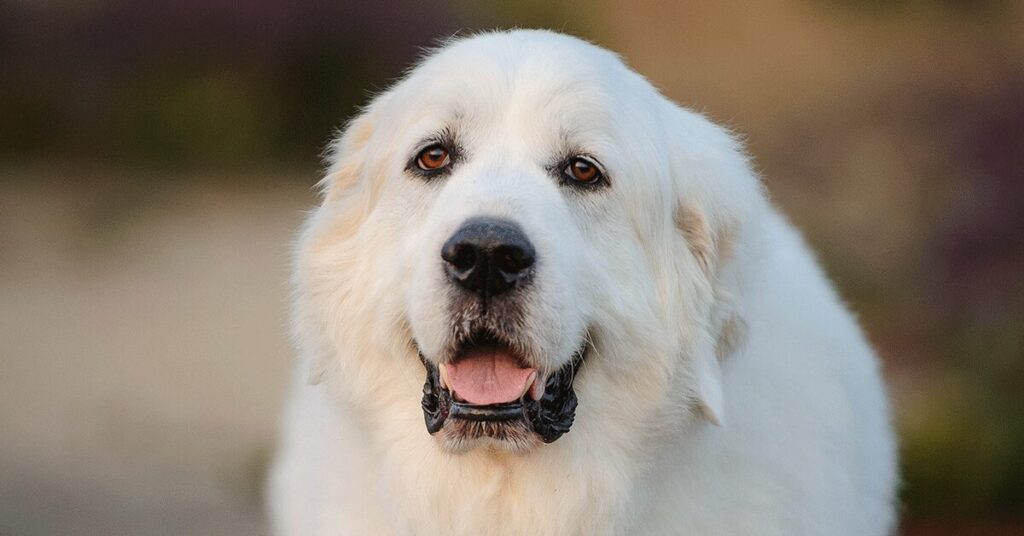
If you’re looking for a calm and intelligent watchdog, a Great Pyrenees may be right for you. These livestock guardians are also known as Le Montagne des Pyrénées due to their French/Spanish ancestry.
An ancient breed, Great Pyrenees can weigh 85 to 100 pounds and measure up to 32 inches. They can be stubborn, so they need a pet owner with experience and a commitment to ongoing training.
Great Pyrenees are known for their white coats, but they can have markings too. You should expect to brush your dog at least once a week and exercise them daily.
Your Great Pyrenees will be protective of its family, but they are better suited to older teenagers or adults. When socialized early, these pups can live side by side with smaller dogs and cats.
The average lifespan is 12 to 14 years.
10. Anatolian Shepherd
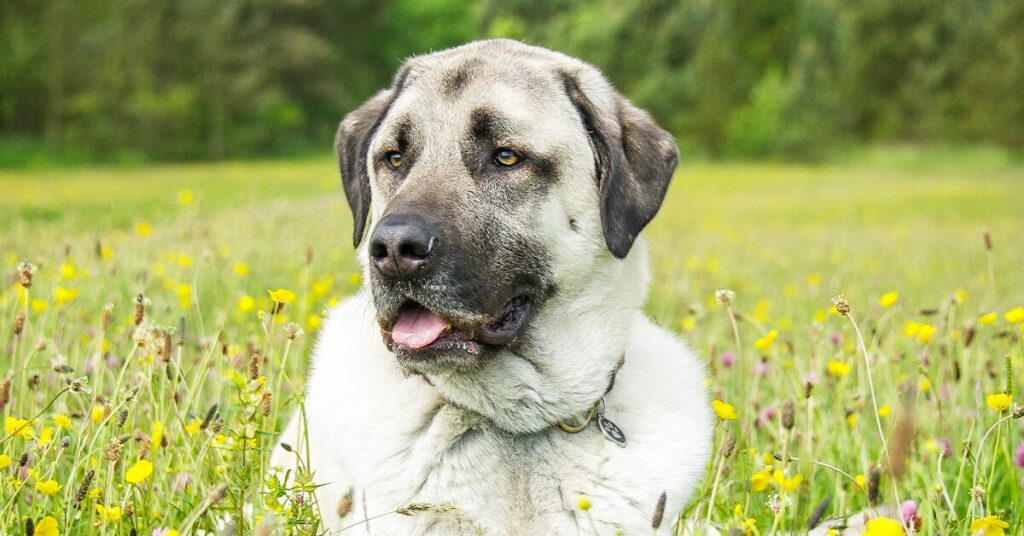
Next up, we have the lovable Anatolian Shepherd. Also known as Karabash and Kangal dogs, the breed is protective, loyal, and always alert. This canine companion will sleep with one eye open, making sure its loved ones are safe.
This is one of the heavier dogs on this list, weighing up to 150 pounds. You can expect your pup to grow between 27 and 29 inches, with an average lifespan of 11 to 13 years.
Caring for an Anatolian Shepherd requires consistent training. They can be stubborn and aren’t always a good fit for homes with young families or other pets.
You’ll need plenty of outdoor space and a fenced yard. Plus, you will have to go for walks for around an hour each day.
11. Dogue de Bordeaux

This giant (and ancient) French dog breed is loyal, affectionate, and courageous. It’s a cousin of the Mastiff, weighs more than 100 pounds, and stands between 23 and 26 inches tall. These dogs are known for their giant heads, muscular bodies, and adorably wrinkly faces.
They’re the perfect companion for anyone looking for a sensitive and affectionate pooch. However, the Dogue de Bordeaux (DDB) can be difficult to train.
DDBs can be stubborn and powerful, which means that they require strict training from a young age. They will dominate those who fail to apply firm discipline in puppyhood and need early socialization. Without rules, they can be aggressive toward other animals.
With that said, they love people and cuddles and will nudge their way onto your couch or into your bed whenever they can. They’re big snoozers and don’t require a ton of exercise; they’re mostly happy to curl up and relax the day away.
12. Cane Corso

Cane Corsos are an 88 to 120-pound, 23.5- to 27.5-inch breed of Mastiff. They are not for faint-of-heart dog owners — but they’re totally adorable. As affectionate as they are majestic, they love their families deeply and fiercely.
So fiercely, however, that they’re not fans of other dogs and strangers. No amount of socialization will make them friendly toward anyone outside their immediate circle.
It’s important to start training your Cane Corso early and with discipline, firmness, and consistency. They need a leader who is kind yet strict, and obedience classes can be helpful.
Cane Corsos have a high prey drive, which means you’ll have to prevent them from hunting cats or small dogs around the neighborhood. The average lifespan for this breed is 9 to 12 years.
13. Mastiff
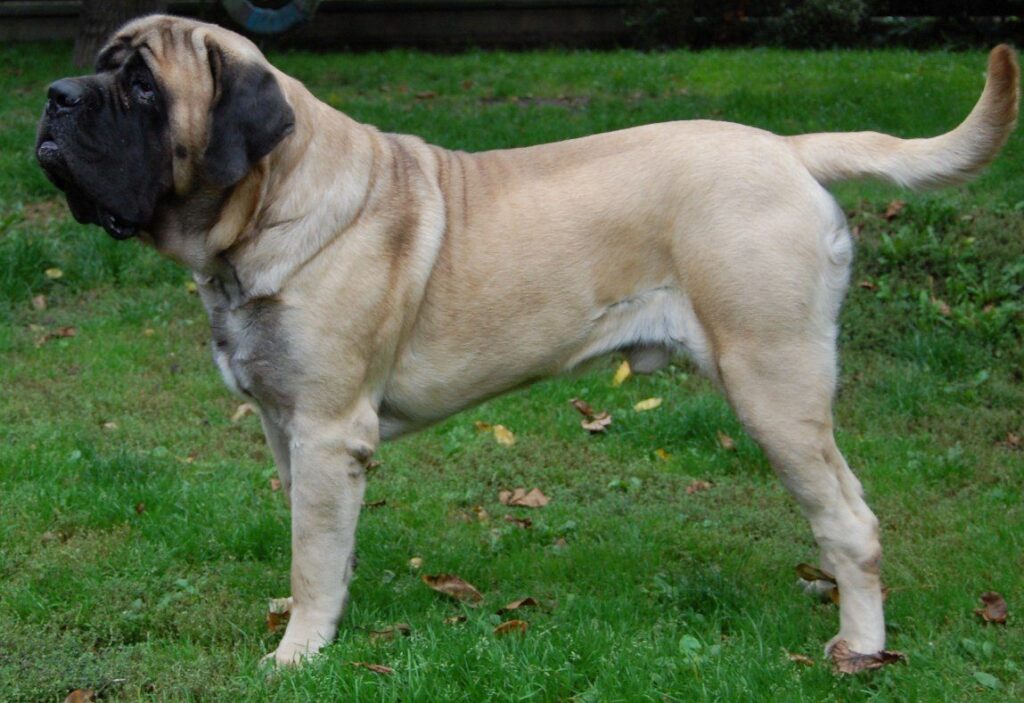
Weighing between 120 and 230 pounds and measuring 27.5 to 36 inches in height, Mastiffs (also known as English Mastiffs) are truly, well, massive. With rectangular bodies and short, shiny coats, these majestic creatures often win gold medals in dog shows.
They not only look good but also win people over with their personalities. Mastiffs are generous with their affection and love playing with young children. They’re highly adaptable and have a low tendency to bark, except when they’re acting as watchdogs.
Mastiffs are courageous protectors, and they can intimidate even the toughest of intruders. However, their fierce loyalty means they can take time to warm up to a stranger.
When training a Mastiff, be gentle. They prefer calm and soothing training and don’t respond well to harsh discipline. Despite what their intimidating size might suggest, they’re good-natured, gentle dogs that just want love, inclusion, and respect.
This breed of pup typically lives for 6 to 10 years.
14. Giant Schnauzer
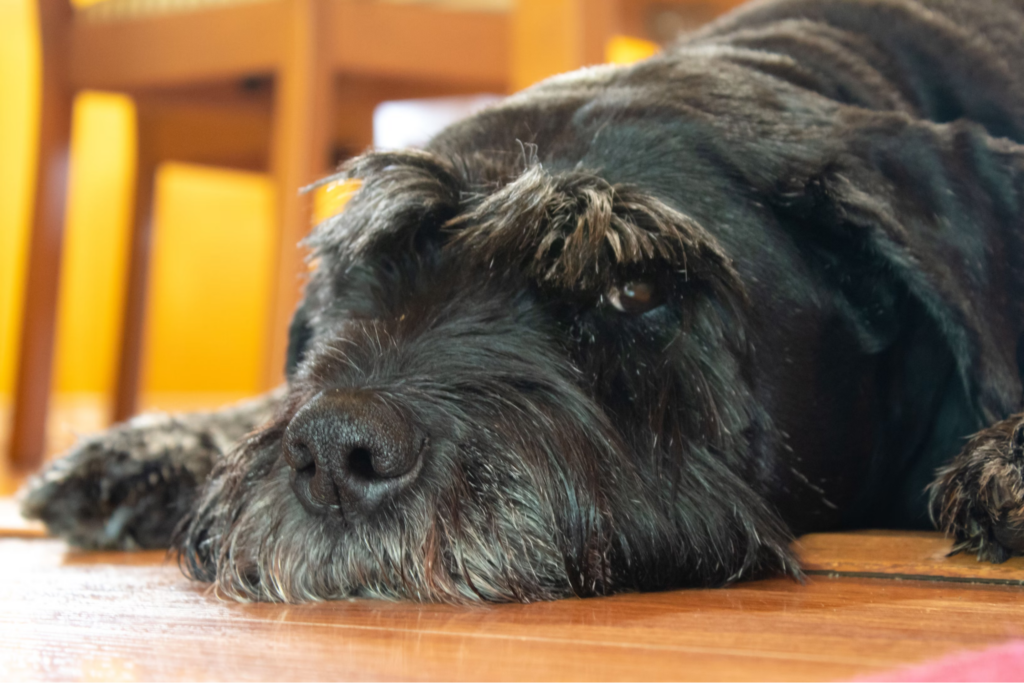
Do you love the look of a Schnauzer but want a bigger dog? You can adopt a giant version of these German pups, complete with the signature mustache, large snout, and long brows.
Giant Schnauzers weigh up to 75 pounds and can measure 23.5 to 27.5 inches. They’re an affectionate and loyal breed that loves their family but can be wary of strangers.
Your new pup will be intelligent and eager to please their favorite person. However, they do require mental stimulation and ongoing training. Giant Schnauzers need lots of daily exercise, but you can mix up the walks with swimming, running, or hiking.
This is a breed with a wiry double coat that needs regular brushing. A trip to the groomer every few months is also recommended to remove the thick undercoat.
If you take home a Giant Schnauzer, you can expect a lifespan of 12 to 15 years.
15. Doberman Pinschers
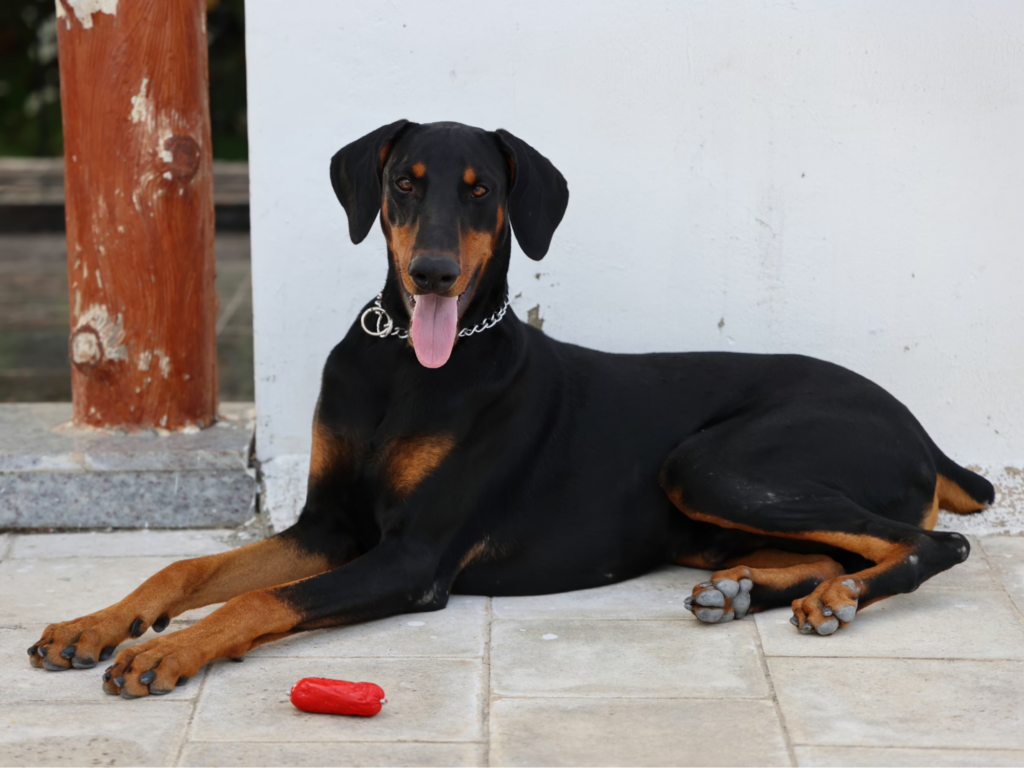
Doberman Pinschers are a unique breed. They’re muscular, athletic, and without fear. If you’re committed to firm training from a young age, you’ll get a protective and loyal guard dog.
This lean and majestic breed can weigh up to 100 pounds and measure between 24 and 28 inches. Even though they can be affectionate, their size and strength aren’t always a good match for homes with young children or other pets.
Dobermans suit active owners who like to get outdoors and take them for walks, runs, or hikes every day. This is a pet that’ll keep you fit and active, and you can keep them happy with a large, enclosed yard with lots of mental stimulation.
Grooming a Doberman Pinscher is relatively easy. Using a short-bristled brush will help keep their fur soft and shiny — and the occasional bath will remove any dirt.
The average life expectancy is 10 to 12 years.
The best big dog breeds for families
Want a big, lovable pup that’s family-friendly? Here are the top big dogs for homes with kids:
- Golden Retriever
- Great Dane
- Leonberger
- Newfoundland
- Saint Bernard
The best big dog breeds for active pet parents
If you are active and want a running or hiking companion, try these breeds:
- Doberman Pinscher
- Giant Schnauzer
- Anatolian Shepherd
- Siberian Huskie
- Greyhound
The biggest dog breeds for protection
For a loyal guardian that’ll protect you and your property, here are some of the best breeds to choose from:
- Doberman Pinscher
- Bullmastiff
- Cane Corso
- German Shepherd
- Belgian Malinois
The biggest dog breeds
Owning a big dog means lots of affection, warmth, and love in your home. But it also means extra work, training, and a shorter life expectancy.
For most big dogs, you’ll need to commit to daily exercise. You’ll also need adequate space for them to stretch their legs and run.
There are lots of giant dog breeds worth considering, including Greyhounds, Mastiffs, and Newfoundlands. The most important thing is to train your dog from an early age and make sure they are socialized to be around strangers and other animals.
Make sure you keep your big dog in good health with lots of exercise, a healthy diet, and regular trips to the vet. When unexpected accidents and illnesses strike, Pumpkin pet insurance plans can help reduce the cost of eligible vet bills in the future, protecting your pup and your wallet at the same time.
FAQs
- https://www.akc.org/dog-breeds/st-bernard/
- https://www.akc.org/dog-breeds/leonberger/
- https://www.akc.org/dog-breeds/greyhound/
- https://www.akc.org/dog-breeds/black-russian-terrier/
- https://www.akc.org/dog-breeds/dogue-de-bordeaux/
- https://www.akc.org/dog-breeds/giant-schnauzer/
- https://www.akc.org/dog-breeds/doberman-pinscher/
- https://www.usatoday.com/story/news/2023/03/22/worlds-biggest-dog-breed/11480217002/
- https://www.akc.org/expert-advice/lifestyle/fun-facts-greyhound/
- https://www.akc.org/expert-advice/health/why-do-small-dogs-live-longer


